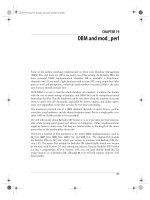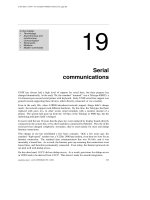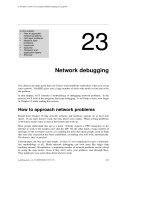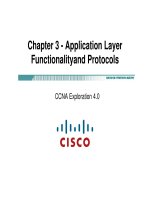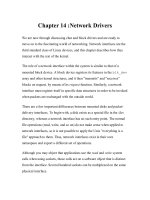Chapter 19 Network Layer: Logical Addressing potx
Bạn đang xem bản rút gọn của tài liệu. Xem và tải ngay bản đầy đủ của tài liệu tại đây (1.05 MB, 59 trang )
19.1
Chapter 19
Network Layer:
Logical Addressing
Copyright © The McGraw-Hill Companies, Inc. Permission required for reproduction or display.
19.2
19-1 IPv4 ADDRESSES
19-1 IPv4 ADDRESSES
An
An
IPv4 address
IPv4 address
is a
is a
32-bit
32-bit
address that uniquely and
address that uniquely and
universally defines the connection of a device (for
universally defines the connection of a device (for
example, a computer or a router) to the Internet.
example, a computer or a router) to the Internet.
Address Space
Notations
Classful Addressing
Classless Addressing
Network Address Translation (NAT)
Topics discussed in this section:
Topics discussed in this section:
19.3
An IPv4 address is 32 bits long.
Note
19.4
The IPv4 addresses are unique
and universal.
Note
19.5
The address space of IPv4 is
2
32
or 4,294,967,296.
Note
19.6
Figure 19.1 Dotted-decimal notation and binary notation for an IPv4 address
19.7
Numbering systems are reviewed in
Appendix B.
Note
19.8
Change the following IPv4 addresses from binary
notation to dotted-decimal notation.
Example 19.1
Solution
We replace each group of 8 bits with its equivalent
decimal number (see Appendix B) and add dots for
separation.
19.9
Change the following IPv4 addresses from dotted-decimal
notation to binary notation.
Example 19.2
Solution
We replace each decimal number with its binary
equivalent (see Appendix B).
19.10
Find the error, if any, in the following IPv4 addresses.
Example 19.3
Solution
a. There must be no leading zero (045).
b. There can be no more than four numbers.
c. Each number needs to be less than or equal to 255.
d. A mixture of binary notation and dotted-decimal
notation is not allowed.
19.11
In classful addressing, the address
space is divided into five classes:
A, B, C, D, and E.
Note
19.12
Figure 19.2 Finding the classes in binary and dotted-decimal notation
19.13
Find the class of each address.
a. 00000001 00001011 00001011 11101111
b. 11000001 10000011 00011011 11111111
c. 14.23.120.8
d. 252.5.15.111
Example 19.4
Solution
a. The first bit is 0. This is a class A address.
b. The first 2 bits are 1; the third bit is 0. This is a class C
address.
c. The first byte is 14; the class is A.
d. The first byte is 252; the class is E.
19.14
Table 19.1 Number of blocks and block size in classful IPv4 addressing
19.15
In classful addressing, a large part of
the available addresses were wasted.
Note
19.16
Table 19.2 Default masks for classful addressing
19.17
Classful addressing, which is almost
obsolete, is replaced with classless
addressing.
Note
19.18
Figure 19.3 shows a block of addresses, in both binary
and dotted-decimal notation, granted to a small business
that needs 16 addresses.
We can see that the restrictions are applied to this block.
The addresses are contiguous. The number of addresses
is a power of 2 (16 = 2
4
), and the first address is divisible
by 16. The first address, when converted to a decimal
number, is 3,440,387,360, which when divided by 16
results in 215,024,210.
Example 19.5
19.19
Figure 19.3 A block of 16 addresses granted to a small organization
19.20
In IPv4 addressing, a block of
addresses can be defined as
x.y.z.t /n
in which x.y.z.t defines one of the
addresses and the /n defines the mask.
Note
19.21
The first address in the block can be
found by setting the rightmost
32 − n bits to 0s.
Note
19.22
A block of addresses is granted to a small organization.
We know that one of the addresses is 205.16.37.39/28.
What is the first address in the block?
Solution
The binary representation of the given address is
11001101 00010000 00100101 00100111
If we set 32−28 rightmost bits to 0, we get
11001101 00010000 00100101 0010000
or
205.16.37.32.
This is actually the block shown in Figure 19.3.
Example 19.6
19.23
The last address in the block can be
found by setting the rightmost
32 − n bits to 1s.
Note
19.24
Find the last address for the block in Example 19.6.
Solution
The binary representation of the given address is
11001101 00010000 00100101 00100111
If we set 32 − 28 rightmost bits to 1, we get
11001101 00010000 00100101 00101111
or
205.16.37.47
This is actually the block shown in Figure 19.3.
Example 19.7
19.25
The number of addresses in the block
can be found by using the formula
2
32−n
.
Note


